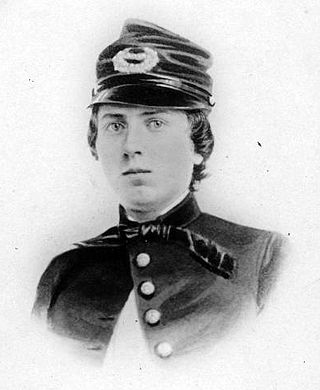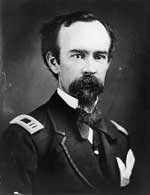
John Freeman Mackie was a United States Marine Corps sergeant during the American Civil War. He was awarded the nation's highest military decoration for valor—the Medal of Honor, for his actions aboard the USS Galena during the battle with Confederate Marines and artillery batteries at Fort Darling near Richmond, Virginia, on May 15, 1862. He is one of the first two Marines to be awarded the Medal of Honor, and is considered to be the first Marine to receive the Medal of Honor in the history of the Marine Corps.

Alonzo Hereford Cushing was an artillery officer in the Union Army during the American Civil War. He was killed in action during the Battle of Gettysburg while defending the Union position on Cemetery Ridge against Pickett's Charge. In 2013, 150 years after Cushing's death, he was nominated for the Medal of Honor. The nomination was approved by the United States Congress, and was sent for review by the Defense Department and the President.

The 2nd Rhode Island Infantry Regiment was an infantry regiment composed of volunteers from the state of Rhode Island that served with the Union Army in the American Civil War. They, along with the 1st Rhode Island, wore a very simple uniform. The uniform composed of a dark blue jacket like shirt, tannish grey pants, and a dark blue chasseur kepi. The 2nd Rhode Island also wore havelocks in the beginning of the war, but after finding them useless they discarded them.

John Milton Deane was an American Civil War Medal of Honor recipient and a major in the United States Army.

Mason Carter was a U.S. Army officer who served in the American Civil War and the Indian Wars during the late 19th century. He received the Medal of Honor for his role in the Battle of Bear Paw fought on January 8, 1877.

James A. Williamson was a politician and lawyer who served in the Union army during the American Civil War, rising to the rank of brigadier general. He received the Medal of Honor for his actions at the Battle of Chickasaw Bayou.

John F. Chase (1843–1914) was a Union Army soldier in the American Civil War and a recipient of the United States military's highest decoration, the Medal of Honor. An artilleryman, Chase earned the medal by continuing to work his cannon despite intense Confederate fire at the Battle of Chancellorsville. He later participated in the Battle of Gettysburg and was severely wounded, losing his right arm, by a Confederate artillery shell. After the war, Chase worked as an inventor before moving to the St. Petersburg, Florida, area. In Florida, he was involved in various business pursuits, including an attempt to form a retirement community for former soldiers in Veteran City, today known as Gulfport.

Frederick W. Füger was an enlisted man and officer in the U.S. Army. He received the Medal of Honor for gallantry during the Battle of Gettysburg while defending the Union position on Cemetery Ridge against Pickett's Charge on July 3, 1863.
The 116th Ohio Infantry Regiment, sometimes 116th Ohio Volunteer Infantry was an infantry regiment in the Union Army during the American Civil War.
Battery E, 1st Rhode Island Light Artillery Regiment was an artillery battery that served in the Union Army during the American Civil War.
Battery G, 1st Rhode Island Light Artillery Regiment was an artillery battery that served in the Union Army during the American Civil War.
Captain George Newman Bliss was an American soldier who fought in the American Civil War. Bliss received the country's highest award for bravery during combat, the Medal of Honor, for his actions to counter a Confederate advance in Waynesboro, Virginia on 28 September 1864. He was honored with the award on 3 August 1897.
John Joyce Carter was an Irish officer who fought in the American Civil War. Carter received the United States' highest award for bravery during combat, the Medal of Honor, for his action during the Battle of Antietam in Maryland on 17 September 1862. He was honored with the award on 10 September 1897.
Benjamin Ham Child was an American soldier who fought in the American Civil War. Child received the United States' highest award for bravery during combat, the Medal of Honor, for his action during the Battle of Antietam in Maryland on 17 September 1862. He was honored with the award on July 20, 1897.
Stephen Edwin Chandler was an American soldier who fought in the American Civil War. Chandler received the country's highest award for bravery during combat, the Medal of Honor, for his action at Amelia Springs, Virginia on 5 April 1865. He was honored with the award on 4 April 1898.
Captain George Wilhelm Corliss was an American soldier who fought in the American Civil War. Corliss received the country's highest award for bravery during combat, the Medal of Honor, for his action during the Battle of Cedar Mountain in Virginia on 9 August 1862. He was honored with the award on 10 September 1897.

Alexander Calvin Elliott was a United States soldier who fought with the Union Army during the American Civil War as a sergeant with Company A of the 1st Pennsylvania Cavalry. He received his nation's highest award for valor, the U.S. Medal of Honor, for his actions at Paines Crossroads, Virginia on April 5, 1865. That award was conferred on May 3, 1865.
John H. Havron was an American soldier who fought in the American Civil War. Havron received his country's highest award for bravery during combat, the Medal of Honor. Havron's medal was won for his extraordinary heroism during the Third Battle of Petersburg, in Virginia on April 2, 1865. He was honored with the award on May 12, 1865.

Peter McAdams was an Irish American soldier who fought in the American Civil War. He emigrated to America at the age of 14 and worked initially as a shoemaker. Upon the outbreak of the Civil War, he enlisted in the Union Army. McAdams fought with the 98th Pennsylvania Infantry at the Battles of Williamsburg and Fredericksburg. He received a promotion to sergeant for his action in rescuing a wounded comrade at the Battle of Salem Church on May 3, 1863. McAdams was later commissioned as an officer and fought in this role at the Battle of Cold Harbor. He was seriously injured and left the army after the war. McAdams was awarded the Medal of Honor on April 1, 1898.

Louis Jeanottelle Sacriste was a first lieutenant in the United States Army who was awarded the Medal of Honor for gallantry during the American Civil War. He was issued the medal on January 31, 1889, for actions he performed in the battles of Chancellorsville and Auburn in 1863.










